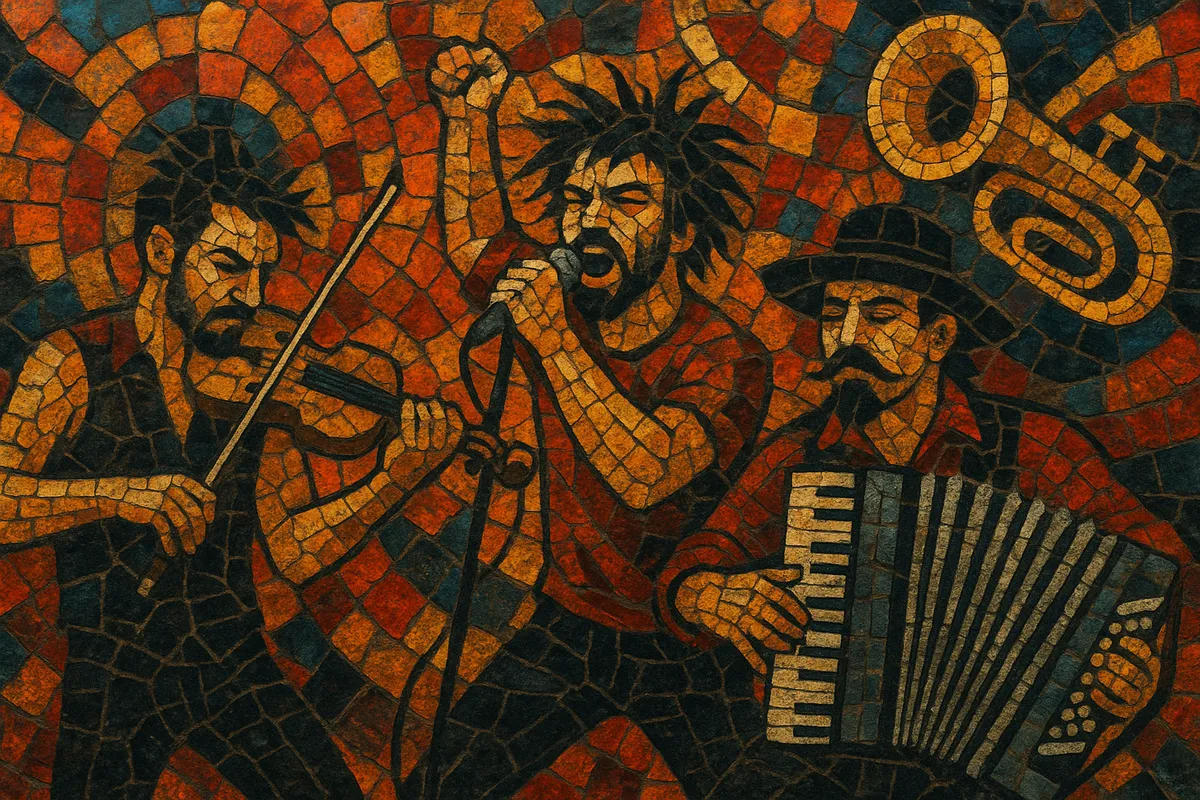
Gypsy punk is a high-energy fusion of Eastern European/Romani folk traditions and Western punk-rock attitude. It combines the fast tempos, power-chord drive, and DIY ethos of punk with violins, accordions, brass, and dance rhythms drawn from Romani, Balkan, and klezmer repertoires.
Songs often feature off-kilter meters (such as 7/8 or 9/8), melodic ornaments, and modes like harmonic minor and Phrygian dominant, while maintaining chantable choruses, gang vocals, and raucous stage theatrics. Lyrically, it embraces themes of migration, identity, resistance, and celebration, frequently delivered in multilingual vocals that reflect diasporic experience.
Gypsy punk’s foundations lie in the meeting of Eastern European/Romani folk music with the energy of late 20th-century punk. Throughout the 1980s and 1990s, global-minded punk and alternative acts experimented with folk traditions, while diaspora communities in Western cities kept Romani and Balkan dance music vibrant. Proto-influences included klezmer revivals, cabaret-tinged punk, and world-traveling rock collectives that opened space for hybrid approaches.
The term "gypsy punk" crystallized in the late 1990s and early 2000s, particularly in New York City’s multicultural scene. Bands like Gogol Bordello brought Romani/Balkan instrumentation into the punk club circuit, mixing breakneck two-step beats with off-meter folk dances, multilingual lyrics, and theatrical performance. Around the same time, groups from Eastern Europe and the diaspora—combining local folk idioms with punk—reinforced the sound on international stages and festivals.
In the 2000s, the style’s reputation grew through relentless touring, word-of-mouth, and festival circuits. Acts from the Balkans, the US, and beyond adopted or paralleled the template: punk rhythm sections backing fiddles, accordions, brass, and cimbalom-like timbres. The visual language—DIY aesthetics, carnival/cabaret flair, and exuberant crowd interaction—became part of the genre’s identity.
Gypsy punk helped normalize hybrid folk-punk in global alternative music, inviting crossovers with ska, cabaret, and electronic scenes. While some bands lean harder into punk aggression and others into acoustic folk or brass-driven dance music, the core remains: a celebration of nomadic identity and defiance expressed through communal, ecstatic performance.
Use a punk rhythm section (electric guitar, electric bass, drum kit) as the engine, then layer folk instruments such as violin/fiddle, accordion, clarinet or sax, trumpet/trombone, and occasional acoustic guitar or cimbalom-like timbres. Aim for a raw, live-room sound with prominent room mics and gang vocals to capture communal energy.
Alternate between straight-ahead punk two-step (fast 2/4) and Balkan dance meters (7/8, 9/8, 11/8). Keep tempos brisk (roughly 140–200+ BPM). Create dynamic push-pull by switching from driving downbeats to syncopated folk grooves and hand-percussion breaks (e.g., darbuka, tupan).
Favor melodic minor colors (harmonic minor, Phrygian dominant) and Eastern European ornamentation (slides, trills, grace notes). Keep harmonies simple—power chords, I–bVII–IV punk cycles—while melodies weave agile, folk-style lines on violin or accordion. Use call-and-response hooks and shout-along refrains.
Write about migration, identity, survival, love, and revelry with wry humor and political edge. Mix languages if possible to reflect diaspora roots. Vocal delivery can be theatrical, raspy, and exuberant, with crowd chants and gang shouts to amplify the communal feel.
Start with a folk instrument intro, slam into a punk verse/chorus, and insert a breakdown that spotlights a dance rhythm or instrumental solo. Build to a big, participatory ending with accelerando or stacked vocal hooks to ignite live audiences.

